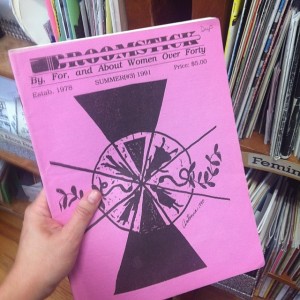Mon, 08/04/2014 - 2:28pm

by Eileen and Sujei
If you’re like me, you have a ton of things on your mind/plate. And although I knew July was International Zine Month, I couldn’t quite pull the trigger on this blog post till now. But, all this information is still valid – and it's always a good time to enjoy and make zines.
But wait – I should slow down, back up – and address a question you may have: What is a zine anyway?
For those of you not into underground, DIY publishing, first things first: Zine (pronounced “zeen”) is short for fanzine. A zine can be produced by anyone with something to say or share. The low cost of making one allows the maker the freedom to produce as many as them as he or she wants, for a limited/small circulation. They are usually cheap or free to obtain, and zinesters like to trade theirs with other makers.
Zines can contain anything one’s imagination can fathom – types of zines: perzines (personal zines), political zines, DIY zines, music zines, art zines, parenting zines, sexuality & gender zines, people of color zines, traveling zines, comics zines, e-zines, etc. They are often made by communities who are marginalized by mainstream society – like the poor or disabled, LGBTQ individuals, people of color, those with radical political views – the list goes on and on. They provide a unique glimpse of contemporary culture that challenges mainstream publishing industry and dominant historical narratives.
What do you need to make a zine? An idea, an interest, a gimmick, a pet peeve. And then you’ll need supplies: Paper, scissors, glue stick, markers, pencil, stapler … and a computer. But, wait, nope, you don’t need a computer or a typewriter. Because zines have been around a long time, many makers don't use electronics to make their zines. Plenty of zinesters hand write or draw their content, cut them out and paste them on a master copy. Then, when satisfied with its content and layout, the maker makes copies of the zine, folds and sometimes staples them together.
But, you may be wondering, how can I obtain access to enough room to lay out my zine and make copies? Well, the library of course! Your local library has tables and chairs and a copy machine so you can make your copies. (SPL’s copiers cost 15 cents per black and white page; 30 cents per color page.) But, you may be thinking, I can’t draw. I can’t write very well. The important thing is to be able to express an idea, love, hate toward a particular topic. But can you fill up one sheet of paper with your art or ideas, no matter how “bad” or “silly” you may think them to be? I’m betting yes.
Boston’s local zine library – Papercut Zine Library – just moved a last month from Lorem Ipsum Books in Inman Square to Allston, for the time being anyway. They are still available for appointments and events, but are not circulating issues. For those who can get to Framingham, the local public library has a young adult zine collection.
And do you enjoy getting snail mail? Promote your zine online through distros or fests and make those trades! Start your own collection. And I’ve even seen zines sold on sites like etsy.com for a few bucks. Chat with other zinemakers on twitter by checking out the hashtag #izm2014 or #zines. Network with other makers at this month's New England Zine Fest and MICE (Massachusetts Independent Comics Expo) in October. You can also catch up with what happened at the RIPE (Rhode Island Publishing Expo) that just happened here.
Here are some sites to give you some ideas:
- http://poczineproject.tumblr.com/
- http://zineopolis.blogspot.com
- http://zines.barnard.edu/
- http://wemakezines.ning.com/
- http://24hourzines.com/
- http://zinewiki.com
- http://www.qzap.org
- http://zinelibraryday.wikispaces.com/
- http://zinelibraries.info
Books in the Minuteman System about Zines and Zinemaking
- Whatcha mean, what's a zine? : the art of making zines and minicomics by Mark Todd + Esther Peal Watson
- Zine scene by Francesca Lia Block & Hillary Carlip
- The Factsheet five zine reader : the best writing from the underground world of zines Collected by R. Seth Friedman
- Start your own zine : everything you need to know to put it into print! by Veronika Kalmar
- Zine : how I spent six years of my life in the underground and finally found myself-- I think by Pagan Kennedy
- A girl's guide to taking over the world : writings from the girl zine revolution Edited by Karen Green and Tristan Taormino


Add new comment